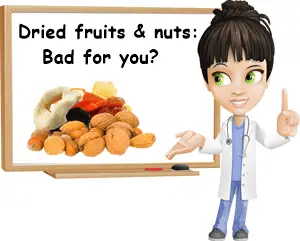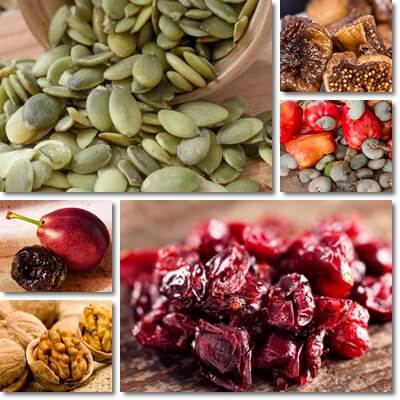Many of us have lived with the earnest belief that eating dried fruits and nuts is good for you. But nutrition principles have long shifted to consider that nuts and especially dried fruits are not that healthy and come with side effects, mostly when eaten in large amounts. What makes dried fruits and nuts bad for you is, first of all, the high sugar and, respectively, salt content, followed by any added ingredients for enhancing flavor or increasing shelf life. Further adding to the side effects of dried fruits and nuts are artificial sweeteners used to counteract the natural bitterness or tartness of some fruits and refined vegetable oils used for roasting different seed and nut varieties.
Are dried fruits and nuts good or bad for you? Both actually, their health effects depending on how much you eat and whether or not you have healthier options available to chose from (they’re still better than processed foods). Ideally, they are meant to be snacked on which basically means you should be only eating small amounts. The main benefits of eating dried fruits and nuts include:

1) You get a high intake of dietary minerals, especially from nuts and seeds.
2) Good vitamin content, except for heat sensitive vitamins like vitamin C.
3) Lots of dietary fiber for good digestion, relieving constipation and healthy blood cholesterol levels.
4) Important source of antioxidants for overall good health.
5) Contain fats for brain health and beautiful skin.
6) Satiating, nourishing and energizing.
How are dried fruits and nuts bad for you?
Just are there are numerous benefits to eating dried fruits and nuts, there are also disadvantages. Here are the top 8 side effects of dried fruits and nuts.
1) High sugar content, bad for teeth, diabetes and weight control. This concerns fruits. Dried fruits are essentially dehydrated fruits, whether they have been left to dry in the sun, in the shade or have been mechanically dried, in a microwave or at home in the oven. By removing water from the fruit, everything else concentrates in the pulp or flesh. From vitamins, dietary minerals, fiber and antioxidants to natural sugars. And in the case of some fruits that are naturally tart or bitter like goji berries, extra sugar may be added to obtain a better, more commercial taste.
This makes dried fruits bad for teeth, increasing tooth decay risks and also bad for anyone struggling to maintain a healthy weight. Despite their moderate to low glycemic index, dried fruits are also not always a good option for diabetics because of their high sugar content which can easily lead to spikes in blood glucose levels and complications. If you do eat dehydrated fruits and have diabetes, it’s best to eat them infrequently and in small amounts and always talk to your doctor first.
2) High salt content, bad for cardiovascular health. This is true for dried nuts and seeds. Salt, like sugar, makes food not necessarily taste better, but rather makes you want to eat more. While it’s an essential nutrient and you need sodium to stay alive and be healthy, too much of it is a problem. Adding salt to nuts and seeds in order to increase consumption of these food products also means creating a predisposition for high water retention, swollen feet, legs and arms as well as high blood pressure with the cardiovascular events it generates over time.
3) Rich in calories, problematic for diabetes, weight management. The calories come from sugars in the case of dried fruits and from fats in the case of nuts and seeds can easily accumulate and lead to weight gain and complications for conditions such as diabetes which require maintaining a healthy weight.
Examples of calorie content of dried fruits vs raw versions:
– Cranberries, raw: 46 kcal/100 g – Cranberries, dried, sweetened: 308 kcal/100 g
– Plums: 87 kcal/100 g – Prunes, unsweetened: 240-275 kcal/100 g
– Fresh apricots: 86 kcal/100 g – Dried apricots: 225-300 kcal/100 g
– Fresh dates: 21 kcal/100 g – Soft, dried dates: 270-300 kcal/100 g
– Raw figs: 74 kcal/100 g – Dried figs: 249 kcal/100 g
– Raw apples: 52-63 kcal/100 g – Dried apples: 243-300 kcal/100 g
– Raw pears: 57-67 kcal/ 100 g – Dried pears: 262-330 kcal/100 g
– Raw peaches: 39 kcal/100 g – Dried peaches: 239 kcal/100 g
– Raw cherries: 63 kcal/100 g – Dried cherries: 300-345 kcal/ 100 g
– Tart cherries: 50 kcal/ 100 g – Dried tart cherries, sweetened: 333-350 kcal/100 g
– Pineapple, raw: 50 kcal/100 g – Dried pineapple, unsweetened: 300-325 kcal, sweetened: 375-380 kcal/100 g

4) Contain added sugar and artificial sweeteners. Naturally tart or bitter fruits like sour cherries, kiwifruit, goji berries and others are often sweetened to enhance their flavor. For this purposes, inverted sugar syrup, processed honey or artificial sweeteners may be used which not only raise calorie content, but are also unhealthy overall. Even nuts and seeds are roasted and sweetened with processed honey, adding to their already high energetic value. Just as important, some fruits like dates, kiwifruit or pineapple are often candied or glazed to make them more palatable, which makes them no longer healthy dried fruit, but candy.
5) Sweetened with processed honey. This practice is mostly reserved for nuts and seeds. To make them more palatable and make people eat more and more, instead of roasting and salting them, they are roasted and sweetened with honey. But real honey, raw, certified is expensive (read about your favorite honey varieties). And since the process has to be made cost-effective, honey blends or honey with added artificial sweeteners or corn syrup is used. It is possible to not even use honey at all, just inverted sugar syrup or corn syrup, which is not healthy at all.
The use of honey blends and other sweeteners when roasting nuts and seeds leads to the formation of a potentially carcinogenic compound called acrylamide. This toxic compound results from the interaction between the amino acid asparagine found in most nuts and seeds and sugars such as glucose and fructose, making honey roasted nuts and seeds a lot less healthy than salted and roasted nuts and seeds.
6) Roasted in processed vegetable oils. In addition to the fat found naturally in nuts and seeds, it is common for producers to also roast these foods in oil for a more special flavor. And because the process has to be cost-effective, hydrogenated and partially hydrogenated oils are used. While the process itself does not change the healthy fats in nuts and seeds, the use of hydrogenated and partially hydrogenated oils does add unhealthy trans fats into your diet, raising your risks of high cholesterol levels and cardiovascular disease over time, assuming you eat roasted nuts and seeds all the time.
7) Contain chemicals. Dried apricots, figs, peaches, raisins, prunes and other dried fruits are often treated with sulfur dioxide to prolong their shelf life. The chemical is also used to enhance color in apricots, peaches and other yellow, orange and bright red fruits. The lighter and brighter the color, the more sulfur dioxide the fruits contain. While it is considered relatively safe for consumption in very small amounts, such as recommended intakes of dried fruits, nuts and seeds (example: 30 g), the compound is bad for anyone with chronic respiratory diseases.
For example, in asthma sufferers, sulfur dioxide can trigger an asthma episode and other breathing-related reactions. In addition to this, it is a known food allergen and can cause anaphylaxis in individuals sensitive to it. Other side effects such as headaches, migraines, sneezing, rashes, throat itching or swelling, itching in the mouth can occur after eating dried fruits containing sulfur dioxide.
8) May contain pesticides and other contaminants. Most of the time, you don’t know where the fruits, nuts and seeds you eat come from or have no real guarantee they come from organic agriculture. For those products that are provided for consumption with skin, pesticides may also be an issue. This is why it’s important to check the label for ingredients and overall choose a food product that guarantees a certain quality.
Conclusion
Dried fruit and nuts are undoubtedly healthy and will provide more benefits than side effects if intake is moderately low. This means it’s okay if you have 10 or 14 almonds as a snack in the afternoon, the next day enjoy a handful of raw sunflower seed kernels and the day after that you have 2-3 dried figs and 2-3 dried plums or a handful of dried goji berries. The only problem is when you eat too much or even when you eat the same dried fruit and nuts every day because this is how unhealthy or less healthy elements accumulate and gain the potential to produce side effects. Keeping intake moderately low is the key to eating dried fruits and nuts and enjoy all the benefits they have to offer, without the side effects. This and choosing raw nuts and seeds and dried fruits from organic agriculture, if possible, unsweetened and without food coloring or additives for increasing shelf life.
